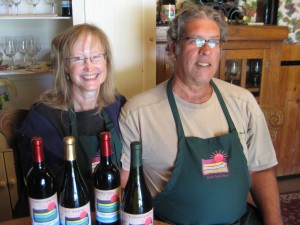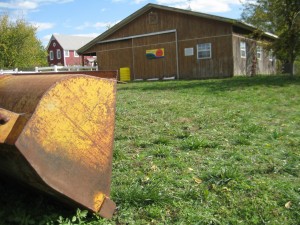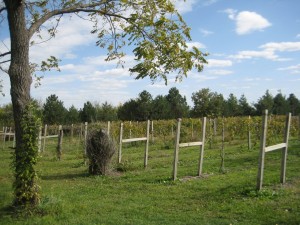Middle Creek Winery – Over the Rainbow in Kansas
At Middle Creek Winery in Louisburg, Kansas, the trees are bending to blustery, autumnal winds. As if to emphasize the drama of a visit from Midwest Wine Press, a tree snaps and crashes to the ground, falling just yards behind winery co-owner Kristin Graue. It doesn’t affect her welcoming smile but husband and co-proprietor, Stephen, looks a little concerned as he watches from the porch of their winemaking facility. The compact winery and tasting room is in a climate controlled converted barn, former home of their late horse and about 50 yards from their house.
The Graues bought the 32 acre property – originally a homestead dating to the 1850s – in 1994 and opened the winery to the public two years ago. Their decision to start a winery was partly inspired by discovering the remains of a 19th century vineyard — a row of vines and a hedge-post trellis — in their yard. A tour of the wine country in neighboring Missouri and the friendly encouragement they received from wineries like Bommarito and Robller helped make up their minds. Stephen recalls the advice, “They said, ‘Just never plan on having a vacation again.’ And they were right!”
‘They call it the Louisburg Split right here. We get strange weather.”
Kristin Graue, co-owner, Middle Creek Winery
During the last decade they’ve planted 4 acres with roughly 2000 vines, divided between 2 adjacent vineyards. The east vineyard, where the vines are 8 years old, has Cayuga, Traminette, Norton, Chambourcin, St Pepin and Chardonel grapes. The west vineyard has 4 year old Norton, Vignoles, Chambourcin and Muscat vines. The couple harvest, crush and bottle their grapes on the premises — sometimes with help from their grown-up children – and also make fruit and mead wines.
‘When we started out we thought everyone liked dry wine,” says Stephen. ‘We were wrong!” Says Kristin, laughing. Stephen retired this year as a human resources director to devote himself to the winery full-time. He attended the University of Nebraska-Lincoln’s winemaking school at Whisky Run Creek Winery and Kristin, who still works full-time at a social services agency, studied winemaking through the Viticulture, Enology Science and Technology Alliance (VESTA) program. During the last decade they renovated the barn and slowly bought equipment, funding everything from their jobs. Within a few years they hope and expect the winery to support them, supplemented if necessary, with their retirement income.
They’ve been sharpening their winemaking skills and adjusting to the demands of their customers. ‘We’ve learned to become more diverse” says Stephen, alluding to their range of dry, sweet and fruit-wines. The fruit for their fruit-wines comes from local farmers and often their own garden, like their persimmon tree. Kristin says fruit wines are especially well suited to telling unique stories to tasting room customers and inspire return visits. ‘So we try to have something new available every few months” she says. ‘There’s a crabapple tree in our front yard and on a whim I made crabapple wine out of it,” continues Stephen. “We only had six gallons and it sold out in 3 weeks, people really liked it. It was crazy!”
To continue reading this post, you must either subscribe or login.[login_form][show_to accesslevel=”annual-membership” ]
However most of Middle Creek’s wines are dry and made from grapes. Their Cayuga White won a bronze medal at last year’s Mid-American Wine Competition. ‘It does well here,” says Stephen. ‘It was developed for the Finger Lakes Region around Lake Cayuga in New York by Cornell and it weathers well in the winter and in the drought and makes a good crisp, dry wine.”
Stephen and Kristin have a relatively non-interventionist, sustainable approach to winemaking and try to use as few chemicals as possible in the vineyard. ‘We let the grapes make the wine,” says Stephen. ‘I take care of the vineyard and do all the things necessary to bring them in and crush them. Grapes respond to that.” They kill the natural yeasts and use Lalvin D47 for their whites, rack the wines until they’re clear but don’t filter them.
‘Right now we have Cayuga in a small steel barrel and we might leave it in there until March and bottle, or we might put it in oak and let it age. We’ll barrel taste it from time to time to see how it’s doing” says Stephen. They often use oak to age the juice rather than impart oak flavors, generally in American barrels (sourced from A & K Cooperage in Missouri) but sometimes French. Middle Creek wines are relatively low in alcohol — 11 to 12% – and sulfites. “We add sulfites at the level of 30 milligrams per liter in our wines,” he explains, “which is considered now, by many commercial wineries, to be in the low end range. We may have to consider increasing that in the future, after we have been in business longer and our wines will need to have longer shelf lives.”
This year’s drought reduced the need for anti-fungicide chemicals. However, the drought and severe frosts significantly lowered yields at many vineyards across the Midwest. The heat was especially tough for Middle Creek Winery. “We don’t have a drip irrigation system.” says Stephen, “So, our own yields on all varietals have been very low in the last two years (2+ tons per acre and under) and probably not representative of the state. We had to haul water in with our livestock tank.” Now that Stephen is retired, they hope to construct an irrigation system.
The weather has been difficult, but this year’s harvest was the best they’ve had, partly because of it. In fact, they didn’t get any severe frosts. ‘We’re in an odd place,” explains Kristin. ‘They call it the Louisburg Split right here. We get strange weather.”
Stephen continues: ‘We lost a certain portion of our crop but we still had the biggest harvest that we’ve had on most of it and that’s kind of an anomaly.” As a result, they expect to double their production to 10,000 bottles.
Possibly the biggest threat to their vines is from a herbicide used by neighboring farmers. The Graues say that for the last two years their grapes have been hit by 2,4-D. ‘When it heats up it becomes an aerosol and can drift for as far as 14 miles and then settle down wherever it decides and it decided to settle on ours this year.” Stephen says it caused 10% crop loss. ‘It’s been in use for sixty years and it’s not going to go away so we just have to deal with it as we can” he adds fatalistically.
It doesn’t seem to have deterred them. In their red wine department, the Graues make an interesting semi-dry red from the Noiret grape (one of several wines I tried) which has jammy, toffee flavors. They also make a Norton-Chambourcin, 50-50 blend that is lightly oaked. ‘It’s been taken pretty well,” says Stephen. ‘Actually it’s the wine that comes closest to what I’d say is a good quality California, heavy-bodied red. The Chambourcin softens the acidity of the Norton and the Norton brings with it the full bodiedness that it has. We really like that aspect of it.”
Stephen has interesting thoughts on Norton’s high acid levels and how to control them: ‘In fact, with our Chambourcin and Norton we don’t put them into oak because I think that brings out a little bit more of the acid qualities, of the Norton especially.” Stephen says he’s discussing the verity of his acid theory with several other winemakers.
See related story: Norton: Dark Knight of American Wine
When they have wine issues and questions, the Graues say their best resource in Kansas is the Highland Community College, in Wamego, which is also a member of the VESTA program. Highland has a research vineyard and a wine chemistry lab onsite. The staff researchers, Dominic Martin and Scott Kohl, hold workshops all over the state, make site visits, and are always available for questions.
Like many small wineries across the Midwest, Middle Creek only sells its wines on-site, but Kansas does allow farm wineries to self-distribute, rather than rely on often costly wholesalers. As their production increases, the couple plans to approach local restaurants and liquor stores.
The Graues, and other wineries in Kansas, like Holy-Field in Basehor, want to build a reputation with 100% Kansas ingredients. This is in spite of a ruling by state legislators in May that halved the required percentage of locally grown grapes — it’s now 30% – that need to be in local wine for it to be called Kansas Wine. ‘We want Kansas wines to be known as Kansas wines, however that perception is taken,” says Stephen. In their favor is what the couple describe as a friendly, collegiate relationship between wineries in this part of the Midwest. They’re especially complimentary towards the winemaking team at Missouri’s Les Bourgeois Winery, Cory Bomgaars and Jacob Holman.
Currently, Kansas is a small part of the Midwest wine industry with about thirty wineries, according to the TTB and the Kansas Department of Agriculture, but the Graue’s are optimistic. ‘We understand that California’s been at it a long time and Missouri’s been at it a long time too, but in due time we will have excellent wines as well and we have some good wines now.”
In this Midwest Wine Press video interview the Graues discuss terroir, their Norton-Chambourcin blend and the regulatory scene in Kansas:
http://youtu.be/vbsB-f-nNMo
[/show_to][password-recovery-link text=’Lost Password? Click here for password recovery.’]
[wp_geo_map]






